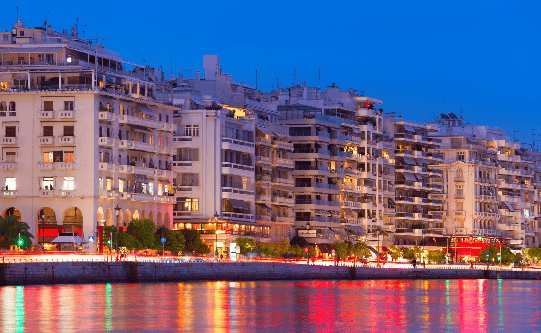Where is the Central Macedonia Region of Greece?
The Central Macedonia Region of Greece is the second most populated region after the Attica region.
To the northeast is Bulgaria, to the east is the Eastern Macedonia and Thrace region, to the south is the Aegean Sea, and to the southwest is the Western Macedonia region.
Central Macedonia’s capital city is Thessaloniki – the second most populated city in Greece after Athens.
The Central Macedonia Region is divided into seven areas:
– Halkidiki
– Imathia
– Kilkis
– Pella
– Pieria
– Serres
– Thessaloniki
The most populated cities are:
Alexandria; Aridaea; Edessa; Giannitsa; Katerini; Kilkis, Koufalia; Litochoro; Naoussa; Nea Kallikratia; Nea Moudania; Polygyros; Polykastro; Thessaloniki; and Veria.
What does the Central Macedonia Region of Greece have to offer?
There is one airport:
– Thessaloniki (international airport)
And nine ports:
– Thessaloniki (the second largest container port in Greece after the Port of Piraeus)
– Aristotelis
– Kassandra
– Nea Propontida
– Sithonia
– Thermaikos
– Ormos Panagias
Agriculture/Products
– Wheat, Corn, Barley, Rye, Rice, Oats
– Pork, Poultry
– Cow, Sheep, and Goat Husbandry
– Potatoes, Beets
– Tomatoes
– Apples, Cherries, Peaches
– Sunflower Seeds
– Olives
– Walnuts
– Grapes
– Tobacco
– Cheese, Yogurt
– Pasta
– Wineries and Vineyards
Cuisine and Restaurants
Restaurants in Central Macedonia offer dishes with a bit more spice to them than the typical Greek dishes we are used to. Perhaps it’s because of
Don’t forget to try the soutzoukakia (meatballs in tomato sauce) and if you dare, the patsas (calves’ hooves, tripe, and belly boiled in water).
If it’s dessert you’re after, the creamy bougatsa here is the best in all of Greece. It is also sometimes made with savory ingredients, such as cheese, spinach, or minced meat.
– Thessaloniki Restaurants
– Alexandria Restaurants
– Aridaea Restaurants
– Edessa Restaurants
– Giannitsa Restaurants
– Katerini Restaurants
– Kilkis Restaurants
– Koufalia Restaurants
– Litochoro Restaurants
– Naoussa Restaurants
– Nea Kallikratia Restaurants
– Nea Moudania Restaurants
– Polygyros Restaurants
– Polykastro Restaurants
– Veria Restaurants
Halkidiki Beaches and Tourism
When you think of Greek beaches, you probably think of the beautiful beaches in the South Aegean islands, not Central Macedonia. Little do people realize, however, how spectacular the beaches are in this region – especially in the Halkidiki peninsula.
Halkidiki is a popular getaway destination among the locals, located about an hour and a half from Thessaloniki. It is divided into three peninsulas (or fingers) that look like a trident – the three peninsulas are Kassandra, Sithonia, and Mount Athos.
More and more tourists visit this area every year. Besides the beaches, there are many places and things of interest to see, such as ancient monuments, Byzantine towers, and spectacular monasteries.
Kassandra
Kassandra is the first peninsula of Halkidiki, located at the westernmost tip of Halkidiki closest to Thessaloniki. It is the most popular peninsula and most densely populated, offering many bars, a vibrant nightlife, restaurants, and large hotels.
This area hosts two major festivals every summer during the months of July and August – the Sani Festival, an international music festival which has been going strong since 1992; and the Kassandra Festival, which takes place at the amphitheater of Siviri (only a few minutes away from Sani). Both offer amazing talent.
The coast of Kassandra has some beautiful areas, however the construction of hotels on the coast has disrupted some of the natural beauty. Despite the construction, there are some beautiful beaches that are definitely worth noting, such as: Sani Beach; Siviri Beach; Aigeopelagitika Beach; Possidi Beach; Chrousso Bay/Xenia Beach; Golden Beach; and Kallithea Beach.
Sithonia
Sithonia is the second peninsula of Halkidiki, or the middle prong of the trident. This area is missing the nightlife and cosmopolitan feel of Kassandra, which is a relief to those who are seeking a more relaxed and natural environment.
Known as the best of Halkidiki, Sithonia offers many beautiful beaches for visitors to explore (92 to be exact), both small and large. Some of the more notable beaches are: Kalogria Beach; Orange Beach/Kavourotripes Beach; Kalamitsi Beach; Karidi Beach; Trani Ammouda Beach; Agios Ioannis Beach; Kalogria Beach; Klimataria Beach; and Armenistis Beach.
Visitors come to laze around on the beach during the day, and to walk along the many promenades in the evening. And of course, to eat fresh fish, seafood, and other local dishes at the many tavernas.
Mount Athos
Mount Athos, the third and most eastern prong, is inhabited by over 2,000 monks from Greece and other countries (such as Bulgaria, Georgia, Moldova, Romania, Russia, and Serbia). It is home to twenty monasteries and has been an Orthodox spiritual centre since 1054. It is a state in and of itself, similar to the Vatican in Rome.
Mount Athos can only be visited by men, and has barred women for more than 1,000 years. Females are not even allowed within 500m of the coast. Interestingly, this applies to both humans and domestic animals, except for cats.
If you are a man and want to visit, a special visa is needed in order to enter the area. Each day, 100 Orthodox and 10 non-Orthodox permits are issued. Permits grant a four day/three night stay at one of the monasteries. Women can go on an Mount Athos cruise and view the monasteries from a distance.
History
The Central Macedonia region has many historical sites and museums, such as:
Dion in Pieria, known for its ancient Macedonian sanctuary of Zeus and city. Remains can be seen in the Archaeological Park of Dion and the Archaeological Museum of Dion. In 2006, a 2200 year old statue of Hera was found built into the walls of the city.
Vergina, in Imathia, is known for the site of ancient Aigai – a UNESCO World Heritage site. Alexander the Great was proclaimed king here in 336 BC after his father (Philip II) was assassinated. This was the first capital of ancient Macedonia, and had an extensive royal palace. The archaeological Museum of Vergina houses the artifacts from the site and is one of the most important museums in Greece.
Pella is best known as the birthplace of Alexander the Great and was thought to have replaced the older city of Aigai as Macedonia’s capital. Here you will find the Archaeological Museum of Pella that houses a head considered to be a portrait of Alexander the Great, as well as a statuette of the god Pan. The size of the palace here (approx 60,000 square metres) indicates that this was also a place of government at one time.
Amphipolis, in Serres, was the battlefield between the Athenians and Spartans that took place in 422 BC. This was also where Alexander the Great strategized on how to best invade Asia. Ancient walls, tombs, and buildings have been excavated and preserved at the Museum of Amphipolis.
~~~~~~~~~~~~~~~~~~~~~~~~~~~~~~~~~~~~~~~~~~~~~~~~~~~~~~~~~~~~~~~~~~~~~~~~~~
See some of our Central Macedonia region recipes here.
Do you have a recipe from this region that you love? Share it with us!

